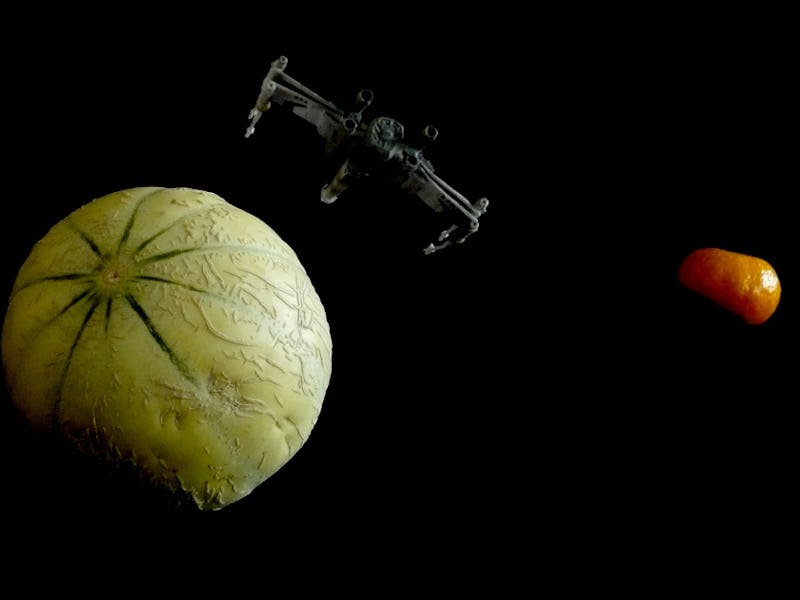6 Changes Coming to Your Local Produce Aisle Soon
An apple a day doesn't keep tomorrow away.

Our produce aisles are constantly in flux. Take the starfruit surge that blossomed in the ‘70s, or the ongoing quinoa and kale crazes, or the ascent of the great and terrible red delicious apple, which, like so many other victims of their own successes, is now a bland copy of its former self. The fruits and veggies we can stuff in our baskets reflect not just our tastes, but a tossed salad of ecological, environmental, and international factors.
When we stroll through the produce aisle of tomorrow, what might it look like?
1. Last Banana
The Cavendish Banana, which you know as “banana,” could become much harder to find, thanks to a fungal disease that’s been devastating the crop for the last decade. Race 4, the fungus, has hit Latin America hard, but the U.S. remains great at importing bananas and even better at eating them. It’s estimated that more bananas are eaten per year than apples and oranges put together.
If there’s a glimmer of silver in this disappearing act, it’s that Kirk Cameron will have to face a cold Darwinian truth: Human-bred, sterile Cavendish bananas were not fit enough to survive.
2. Printberry
If UK’s 3-D printing company Dovetailed has its way, there will be a new way to get produce: berry-like treats mixed by machine. Dovetailed’s tabletop printer cribs heavily from molecular gastronomy, combining fruit juices and spitting out globby bunches akin to raspberries. To CNET, Dovetailed founder Vaiva Kalnikaitė is bullish on berries and disrupting nature: “We have re-invented the concept of fresh fruit on demand.”
3. Bee Minus
Over the past decade, bee populations have been dropping as the insects disappear from their hives in what’s known as colony collapse disorder. Were bees to be wiped out, the loss would cause $15 billion in agricultural damage, according to the Natural Resources Defense Council; bees are key pollinators of crops as diverse as apples, olives, and watermelons. In 2013, Whole Foods teamed up with the pro-insect Xerces Society to create the grimmest supermarket produce campaign in history. It’s worth a second look.
4. GMOs ASAP
For better or worse, our farming future will be genetically modified. In the ever-escalating war that pits farms against weeds, pests, and disease, herbicide-resist crops and intense chemical treatments represent super effective deterents. Dow has patented a way for crops to resist nice types of weedkiller. As Montana State University ecologist Bruce Maxwell told Wired, before we can get to the point where we improve our herbicidal solutions, “In the meantime, unfortunately, we’re going to do some damage.”
5. Starfruit Supernova
Starfruits haven’t conquered the American palette like the banana, but they’re not so unusual you’d be stunned to see them at the grocer’s. Before a Floridian named Morris Arkin popularized the fruit in the 1970s, they were incredibly tough to find. One sweet fruit that has the potential to blow up like the starfruit? The mangosteen. Cheap and popular abroad, like the starfruit was, the mangosteen’s white citrusy flesh is so delicious it’s inspired paeans in The New York Times. Because due to fears of pests, importing mangosteens from the tropics — where they grow best — was banned for decades. In 2007, thanks to anti-pest irradiation techniques, the Agriculture Department creaked open the door for Thai mangosteens to enter the country. Other fruits to watch: the Brazilian feijoa, the Mexican sapodilla, and the Chinese sacred lotus.
6. Bacterial Freshness
Shelf-life is a big deal for produce. Breeding delicious apples to stay ripe and red came at the cost of taste, so the thinking goes. But one way to keep fruit ripe longer without mucking about in plant DNA could be the soil bacteria Rhodococcus rhodochrous. The bacteria produces an enzyme that curbs plant production of ethylene, which is the gaseous signal tomatoes and other fruits use to trigger ripening.